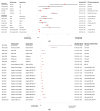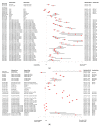Predictors of Adverse Pregnancy Outcomes in Pregnant Women Living with Obesity: A Systematic Review
- PMID: 35206265
- PMCID: PMC8872310
- DOI: 10.3390/ijerph19042063
Predictors of Adverse Pregnancy Outcomes in Pregnant Women Living with Obesity: A Systematic Review
Abstract
Obesity is a well-recognized risk factor for pregnancy complications. Most studies to date are in large cohorts, with results presented in a way that assumes all women living with obesity are at equal risk. This study investigates which women living with obesity are at higher risk of specific pregnancy complications. A systematic search of MEDLINE and Embase identified 7894 prospective or retrospective cohort studies exploring predictors of adverse outcomes among pregnant women living with obesity. Following screening, 61 studies were deemed eligible. Studies were selected if the effects of exposure to any predictor amongst pregnant women living with obesity could be collected. Maternal characteristics assessed for association with adverse outcomes included maternal age, race/ethnicity, maternal height, mode of conception, complement activation factors, and history of various comorbidities/procedures. Gestational diabetes mellitus was the most studied outcome (n = 32), followed by preterm birth (n = 29), preeclampsia (n = 27), low birthweight infants (n = 20), small for gestational age newborns (n = 12), and stillbirth (n = 7). This review identified important characteristics that should be considered during the screening and follow-up sessions of pregnant women living with obesity, including pre-existing type 1 diabetes, maternal age < 20 years or ≥35 years, non-White ethnicity, abdominal adiposity obesity, and history of bariatric surgery.
Keywords: adverse outcomes; obesity; predictors; pregnancy.
Conflict of interest statement
The authors declare no significant competing financial, professional, or personal interest that might have influenced the work described in this manuscript.
Figures






References
-
- Health Nexus . Obesity in Preconception and Pregnancy. Best Start Resource Centre; Toronto, ON, Canada: 2013.
Publication types
MeSH terms
Grants and funding
LinkOut - more resources
Full Text Sources
Medical

